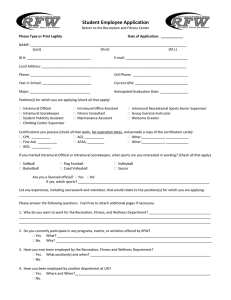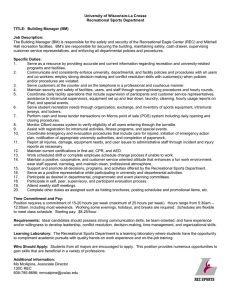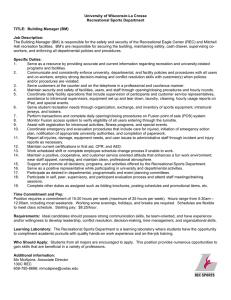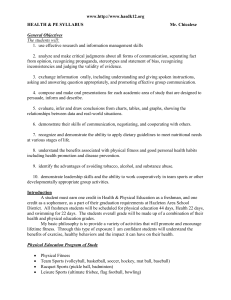University of Louisville Department of Intramural and Recreational Sports Review Programming
advertisement
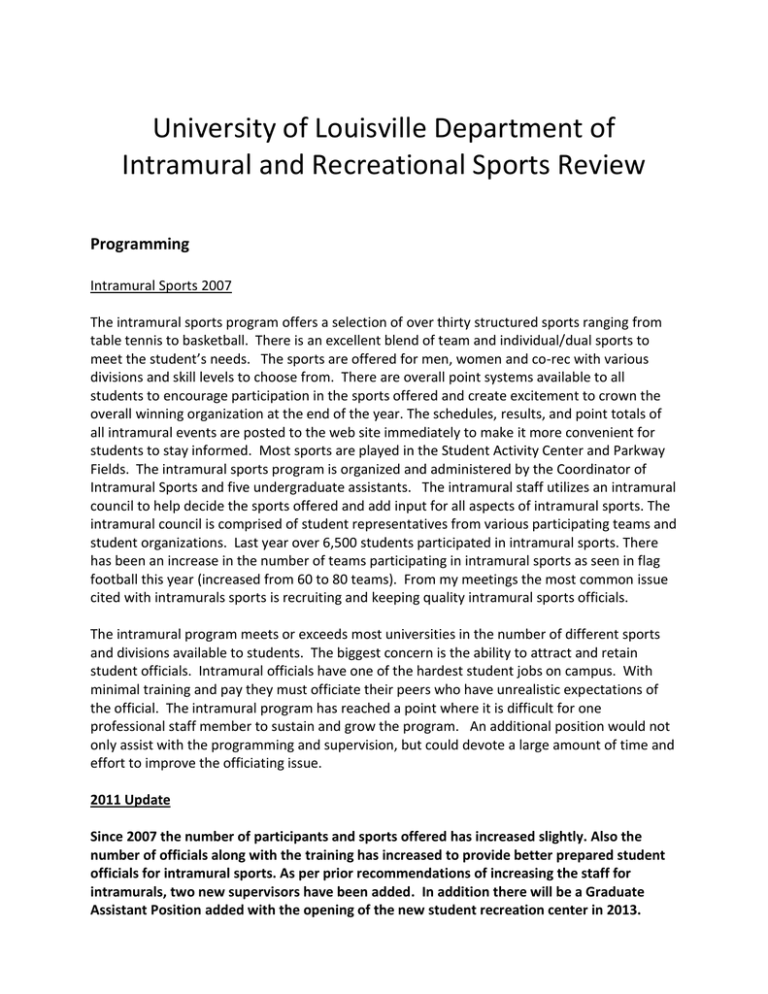
University of Louisville Department of Intramural and Recreational Sports Review Programming Intramural Sports 2007 The intramural sports program offers a selection of over thirty structured sports ranging from table tennis to basketball. There is an excellent blend of team and individual/dual sports to meet the student’s needs. The sports are offered for men, women and co-rec with various divisions and skill levels to choose from. There are overall point systems available to all students to encourage participation in the sports offered and create excitement to crown the overall winning organization at the end of the year. The schedules, results, and point totals of all intramural events are posted to the web site immediately to make it more convenient for students to stay informed. Most sports are played in the Student Activity Center and Parkway Fields. The intramural sports program is organized and administered by the Coordinator of Intramural Sports and five undergraduate assistants. The intramural staff utilizes an intramural council to help decide the sports offered and add input for all aspects of intramural sports. The intramural council is comprised of student representatives from various participating teams and student organizations. Last year over 6,500 students participated in intramural sports. There has been an increase in the number of teams participating in intramural sports as seen in flag football this year (increased from 60 to 80 teams). From my meetings the most common issue cited with intramurals sports is recruiting and keeping quality intramural sports officials. The intramural program meets or exceeds most universities in the number of different sports and divisions available to students. The biggest concern is the ability to attract and retain student officials. Intramural officials have one of the hardest student jobs on campus. With minimal training and pay they must officiate their peers who have unrealistic expectations of the official. The intramural program has reached a point where it is difficult for one professional staff member to sustain and grow the program. An additional position would not only assist with the programming and supervision, but could devote a large amount of time and effort to improve the officiating issue. 2011 Update Since 2007 the number of participants and sports offered has increased slightly. Also the number of officials along with the training has increased to provide better prepared student officials for intramural sports. As per prior recommendations of increasing the staff for intramurals, two new supervisors have been added. In addition there will be a Graduate Assistant Position added with the opening of the new student recreation center in 2013. Moving forward I would recommend exploring software options for scheduling and online applications. Fitness 2007 The fitness program is coordinated by an Assistant Director of Intramural and Recreational Sports who also has facility responsibilities. The fitness program offers group fitness classes, fitness assessment, and health and fitness days. The group fitness classes are offered at both the Health Science Campus Fitness Center and the Student Activities Center. The group fitness studio in the Student Activity Center is converted from two racquetball courts. Classes offered range from Step Aerobics to Cardio-Kick. Yoga and Pilates classes are offered at the Health Science Campus Fitness Center. Yoga and Pilates cannot be offered at the Student Activity Center because of the noise with the racquetball courts. The cost for group fitness classes is $40 per semester. The group fitness classes are offered at noon time and early afternoon (generally 5:15pm – 6:15pm) at both locations. Fitness assessments (assess blood pressure, heart rate, body composition, cardiovascular, flexibility etc.) are available to students for $10. Fitness assessments are done by appointment only during certain times at both facilities. The health and fitness days are scheduled at various times throughout the semester at the Humana Gym, Student Activities Center weight room and Health Science Campus Fitness Center. During these scheduled times the fitness staff is there to answer fitness related questions (workouts, how to use equipment etc.) from students. Fitness has been the fastest growing area nationwide. Students are now more health conscious than ever before. Students want more fitness and wellness opportunities and programs. Offering more group fitness classes (particularly in the afternoon and evening time), fitness/wellness programming (healthy eating chooses, fitness challenges etc) and expanding the availability of fitness assessments and fitness days are needed. The fitness program needs additional funding and a full time position dedicated to meeting the fitness and wellness needs of the students 2011 Update The demand for fitness has continued to increase while the current lack of facilities has hindered meeting that demand. In the last review it was recommended to add personnel and funding to help keep up with the need. With the opening of the new student recreation center in 2013 there will be a full time position and a graduate assistant dedicated to fitness. In addition to the added positions the new facility will add enough state of the art fitness space to add sufficient group fitness classes, programming (nutrition, healthy cooking classes etc.), personal trainers and other popular fitness options. Informal Recreation 2007 One of the most important services provided to students is the opportunity to participate in sports/recreational activities in an informal, unstructured setting. Students are free to choose their own activities and participate at their own skill level and pace. Given the current indoor facilities, the staff has maximized the available time for informal recreation. Informal recreation is available at the Student Activities Center, Human Gym and the Health Science Campus Fitness Center. Between the three facilities there are over 300 hours of informal recreation available per week. Activities available include volleyball, basketball, badminton, squash, racquetball, wallyball, weight lifting, cardio workouts (treadmills, exercise bikes etc.), billiards, table tennis, board games and a video gaming room. There are two areas lacking in informal recreation: not enough fitness equipment (limited by space) and limited outdoor field space available for informal recreation. 2011 Update The main issue in 2007 was the lack of adequate indoor and outdoor recreation space. The new student recreation center will remedy those issues. The 128,000 sq ft new student recreation facility along with an adjacent artificial turf field will provide an adequate amount of quality indoor and outdoor informal recreation space. Sports Clubs Sports Clubs are groups of students that organize because of a common interest in a sport. These organizations are self administrated and regulated by the students. Sports Clubs allow the student to further pursue their interest, whether by intercollegiate competition or just meeting on a regular basis to improve their skill. The Sports Club program currently has 18 clubs. There is a nice blend of clubs that range from Lacrosse to Ballroom Dance. The Sports Clubs are governed by the Sports Club Federation. This group is comprised of one delegate from each of the currently recognized sports clubs. These delegates meet three times per semester to discuss current club issues and report on club activities. Because of limited outdoor field space some of the more traditional outdoor sports clubs (rugby, soccer, field hockey etc.) are not offered. 2011 Update The number of sports clubs continues to increase while using limited out dated facilities. In spite of the lack of outdoor space mentioned in the previous review two new outdoor club sports were added (soccer and rugby). The new student recreation center will provide quality space for all indoor sports clubs under one roof. The new turf field will provide some relief from the lack of field space. Facilities Student Activities Center The recreational sports area of the Student Activities Center has five racquetball courts, two squash courts, a four court multi-purpose gymnasium that can be used for basketball, volleyball and badminton, and five thousand square feet (some from converted racquetball courts) of cardio and fitness equipment. The amount of multi-purpose court space and racquetball courts seems adequate. The amount of space for cardio and fitness equipment falls short of what is needed. The Student Activities Center was built just before the skyrocketing of fitness in campus recreation. It follows the pattern of other facilities built during that era that try to compensate for lack of fitness space by manufacturing space (like converting racquetball court space). The staff has maximized the amount of cardio and weight equipment that can fit. Waiting lists are used for cardio equipment during high volume times and time is limited to 30 minutes per person on a piece of equipment. This is done to maximize the number of people that can use the equipment. But 30 minutes can barely be called a cardio workout. This becomes very frustrating and discouraging to students. More space is needed for fitness. The staff has captured all the space that could currently be converted without taking too much from the other sports areas. Major renovation would be a good option. Humana Gym The Human Gym has a multi-purpose gym, a mat room, a fitness room with limited cardio and weight lifting equipment, saunas, and locker rooms. With free parking and no crowds it is a viable option for off campus students. It is home to several club sports and has a loyal following. This facility seems to have found its niche. Continuing cosmetic improvements and updating equipment would make this facility more appealing. Health Science Campus Fitness Center The HSC Fitness Center was built seven years ago and serves the Health Science Campus. This facility has an open fitness area that contains 21 pieces of cardiovascular equipment, a complete line of 15 pieces of selectorized weight training equipment, and a free weight training area. The fitness center also has an aerobics studio and locker rooms. Although there are times this facility is crowded, it seems to meet the needs for the Health Science Campus. Cardinal Corner Game Room The Cardinal Corner Game Room provides a place for students to play billiards, table tennis, cards or board games. The back part of the room has become the gaming room (a place to play video games). The billiard and table tennis area is adequate. The gaming room currently is not equipped to handle the number of students who want to participate. The video gaming room could be made more appealing by adding more monitors and internet connections. Parkway Fields This lighted Bermuda grass field is well maintained and a quality outdoor field area. This space is used primarily for intramural sports. This field is locked except when used by intramurals or scheduled special events. The consistent feedback received from students was a lack of open outdoor field space. Finding a way to open this field more while still keeping it in playable shape would help in this area. 2011 Update With the scheduled opening of the new student recreation center in 2013 the program will go from a lack of adequate indoor facility space to having ample state of the art indoor recreation space. With the addition of an artificial turf field in 2013 the outdoor recreation space will improve. Future plans should include a state of the art outdoor sports field complex. This would dramatically improve the outdoor field space issue for intramural and club sports. Funding The staff has done a tremendous job maximizing their budget. After all expenses are paid there is about $20,000 left to purchase new equipment and perform regular maintenance. A significant amount of the budget is soft money that is generated from camps and other outside entities. The lack of funding has put a tremendous challenge on the staff to run a quality program while scratching for every dollar. Student fees dedicated to the Intramural and Recreational Sports Department would remedy the budget issues. There currently are no student fees earmarked for the Department of Intramural and Recreational Sports. Most programs across the country and particularly in our state are funded in part by student fees. Currently the students at the University of Kentucky pay $56.75 per semester for full time students and a pro-rated portion for part time students directly to the Campus Recreation Department. 2011 Update When the new student recreation facility opens in 2013 funding of the department should be vastly improved. The $98.00 student fee should adequately fund the personnel expenses, equipment, and maintenance costs. It is imperative to have a reserve account to cover replacement costs of equipment. This account should have no less than $100,000.00 a year deposited. Marketing and Assessment The department is very sound in these areas. They take full advantage of the web and existing marketing opportunities within the university. The department is well ahead of the curve with assessment and applying the CAS standards for measuring learning outcomes. The Marketing and Assessment Planning, Strategy and Implementation Schedule for 2007-2008 publication is very impressive. 2011 Update Marketing and assessment continues to be strong areas. The relationship with Nelligan Sports Marketing is unique for an intramural recreational sports department. This provides a great opportunity to increase revenue. On the promotional side of marketing the department continues to take advantage of all the electronic and social media available in reaching students. Assessment has become a vital component of an intramural recreational sports department. The department continues to be strong in assessing, evaluating and putting in an action plan for programs and facilities. Risk Management The goal of risk management is to provide a safe environment for students. Through staff training employees are made aware of their responsibilities and the proper policy and procedures to follow to provide a safe environment for participants. The Department of Intramural and Recreational Sports has one manual that covers all risk management procedures (Intramural Sports Risk Management). This is an invaluable resource for a quick reminder or refresher of proper procedures to follow to ensure a safe environment or to manage incidents when they occur. The risk management practices are on par with or above most universities. 2011 Update The department’s risk management practices continue to be at or above most universities nationally. New Student Recreation Center Considerations and Review In addition to providing a badly needed facility for current students the new student recreation center (SRC) will become a vital component in the recruitment of new students. The SRC will provide an aesthetically pleasing, safe and healthy place for students to work out and socialize. This will increase student satisfaction which is critical in the retention of students. Given the importance of this facility it is vital that it is properly funded to keep it looking new and current years down the road. The current proposed budget should make that possible. It is critical the proposed $100,000 per year (at minimum) is put in to a reserve fund to be able to repair and replace the equipment as needed. It also will be vital to keep the appearance of the building looking new. Since the maintenance costs are being paid by the student fee for this particular facility the Director of the Intramural and Recreational Sports Department should make the call on when painting, replacing carpet and other cosmetic maintenance should be done. Staffing The student wage line might need to be increased to allow flexibility in wages for different student positions and the possibility of additional student positions as needed. Since this is driven by student fees the more student employment at good wages that can be provided the more the students benefit. For the full time positions make sure you budget in the cost of benefits. The three full time facility managers working the Monday through Friday shifts and Graduate Assistants working the weekends will provide good supervision of the SRC. The number of student staff may vary as usage patterns and needs are determined. At minimum there should be a student worker in the main fitness area on the first floor and a student worker on the second floor. There should be a third worker making rounds at least every hour through the whole facility. The worker making the rounds can take a head count of users in each of the activity areas. This will provide data for traffic patterns for each area. The student workers can also do light cleaning in their areas (wiping down cardio machines etc.). The number of student staff at the control desk for access will be determined by need (washing towels, equipment check out, selling guest passes, giving tours etc.). The work load for the unit business manager will significantly increase in the SRC. The increase in the number of student employees to put on payroll and time keeping will be significant. In addition there will be a huge amount of cash coming in from memberships and guest passes that will need to be processed per university regulations along with the increase in day to day purchases that will need to be processed. The huge amount of increased work load and responsibility would be too much to expect the unit budget manager to continue responsibilities outside of the Intramural and Recreation Sports Department. In fact this position may need additional support. Cash Handling Anywhere cash or checks will be handle make sure appropriate checks and balances are in place and all university cash handling policies are followed. Cash drawers should be used at all purchase points and safes should be available. If at all possible make faculty/staff memberships available through payroll deduction. It is highly recommended to accept credit cards for payment. Most students use their debit/credit card as opposed to cash or checks. Technology A major component to have in place prior to opening the SRC is a comprehensive software package. The software should be able to receive daily downloads from the university of current students and faculty staff. The software should encompass facility access, biometrics, memberships, guest passes, locker rental, equipment check out, product purchases, facility reservations and the capability of on-line applications (entries, reservations etc.). This should be in place in ample time for test runs and training prior to opening. Some consideration should be given to security cameras located at the control desk and locations students may place their belongings (cubbies, hallway lockers etc.) to help deter and/or catch people stealing. With the day use lockers digital locks built in might be a consideration. Students typically will not bring locks with them and tend to put their belongings in an unlocked locker. Locks could be purchased and checked out to students but this would cause more congestion at the equipment check out area. Quality radios will be needed for student workers in different areas to communicate. For the student employees making rounds and counts ipads might be used as opposed to paper check lists. Ipads combined with google docs would make this information available instantly and in a spread sheet format. Operational issue to consider: Custodial With the number of people that will be using the SRC it will be important to have a custodial (male and female) presence in the building during a large portion of the open hours. Ideally the locker rooms would be cleaned when the facility is closed. Maintenance Designate a point person to receive all maintenance problems. This person will determine if it’s an in house issue or physical plant issue and contact the right people. Faculty/Staff Memberships There will be some push back from Faculty/Staff having to pay for the SRC. Most will understand it is built with student fees and the students have to pay. If the current space in SAC could remain available at no cost to faculty/staff that would be a huge help in the transition, even if it is short term. A determination will need to be made if non-student memberships are going to be sold by semesters or by month. Memberships sold by the month (set a minimum number of months) avoids the prorate issue if sold by semester. In addition if payroll deduction is available monthly will be easier. Student Memberships Determining when the Fall, Spring and Summer memberships for students begin and end can be difficult. A determination will need to be made on the schools semesters that have different starting and ending dates. The universities Law, Medical, Dental and Pharmacy schools may have different starting and ending dates than the general graduate and undergraduate student. Spouse/Domestic Partner Memberships It will need to be determined if the university affiliated person must be a member in order for the spouse to join. Dependant passes/memberships and age restrictions for the facility What is the minimum age to use the facility? Do you have age restrictions for certain areas only (weight lifting area) or the whole facility? Can dependents get memberships? If you want to allow dependent memberships for children less than 18 years of age you will need to supervise the building appropriately reflecting the minimum age allowed in on their own. If you have age restrictions for certain areas of the facility it will require appropriate staffing to consistently enforce the restricted area. Guest Passes What is the cost of the guest pass? Will there be a limit on how many guests one member can bring? Is the guest pass good for the day or per visit? The guest must meet the minimum age restrictions of the SRC. Guest pass could be used in lieu of dependent membership. Member Forgets ID With new software you will have access to pictures and information to verify a student. The decision would be whether there is a limit of the number of times they can do this each semester. Outside Personal Trainers There will be non intramural recreational sports department personal trainers attempting to train clients in the new SRC. Most universities do not allow this sighting risk management and using state facilities for personal profit concerns. Summary The Intramural and Recreation Sports Department has done an outstanding job in providing the best program they can while currently lagging behind most benchmark universities in facilities, personnel and funding. With the addition of the new student recreation center in 2013, University of Louisville will have a state of the art facility and programs befitting an institution of their stature. The demand for more fitness equipment and opportunities has continued to increase while the current lack of facilities has hindered meeting that demand. In the last review (see attached) it was recommended to add personnel and funding to help keep up with the need. With the opening of the new student recreation center in 2013 there will be a full time position and a graduate assistant dedicated to fitness. In addition to the added positions the new facility will add enough state of the art fitness space to add sufficient group fitness classes, programming (nutrition, healthy cooking classes etc.), personal trainers and other popular fitness options. Since 2007 the number of intramural participants and sports offered has increased slightly. Also the number of officials along with the training has increased to provide better prepared student officials for intramural sports. As per last reviews recommendation of increasing the staff for intramurals, two new supervisors have been added. In addition there will be a Graduate Assistant Position added with the opening of the new student recreation center in 2013. Moving forward I would recommend exploring software options for scheduling and online applications. The main issue for informal recreation in the last review and still remains an issue is the lack of adequate indoor and outdoor recreation space. The new student recreation center will remedy these issues. The 128,000 sq ft new student recreation facility along with an adjacent artificial turf field will provide an adequate amount of quality indoor and outdoor informal recreation space. Sports clubs continues to increase while using limited out dated facilities. In spite of the lack of outdoor space mentioned in the previous review two new outdoor club sports were added (soccer and rugby). The new student recreation center will provide quality space for all indoor sports clubs under one roof. The new turf field will provide some relief from the lack of field space. When the new student recreation facility opens in 2013 funding of the department should be vastly improved. The $98.00 student fee should adequately fund the personnel expenses, equipment, and maintenance costs. It is imperative to have a reserve account to cover replacement costs of equipment. This account should have no less than $100,000.00 a year deposited. Marketing and assessment continues to be strong areas. The relationship with Nelligan Sports Marketing is unique for an intramural recreational sports department. This provides a great opportunity to increase revenue. On the promotional side of marketing the department continues to take advantage of all the electronic and social media available in reaching students. Assessment has become a vital component of an intramural recreational sports department. The department continues to be strong in assessing, evaluating and putting in an action plan for programs and facilities. With the scheduled opening of the new student recreation center in 2013 the program will go from a lack of adequate facilities and funding to a state of the art recreation space with appropriate funding for the department. Future plans should include a state of the art outdoor sports field complex. This would complement the new student recreation center along with dramatically improving the outdoor field space issue for intramural and club sports.
